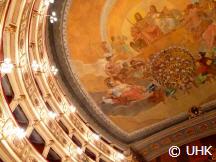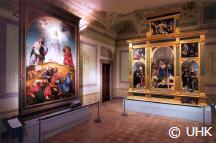Like pearls - the art and cultural works

Later fame of the artists and no-names
The most outstanding artists of the brands are Carlo and Vittorio Crivelli, Pietro Alemanno, Adolfo de Carolis, Lorenzo Lotto and the Ghezzi family of painters. Not to forget the unknown “master from Offida”, who was probably a monk. Not everything that is special and valuable is due to one of them. Many unknown artists created works that are no less impressive. What they all have in common, however, is that they only became "sought-after artists" centuries later. However, some Marchigians achieved enormous fame during their lifetime, including Raphael and Bramante.
The museums and art galleries of the Marche offer an inexhaustible source of wonderful exhibitions and the best thing is that you don't have to queue up!
Le Marche are the region of superlatives of culture and art, not centered on one or two places, but as if poured over the whole area.
It is not for nothing that two slogans in a few words outline what distinguishes the region: "All of Italy in one region" and the other: "Le Marche - a single open-air museum".

|

|

|

|

|

|
Buildings of grandiose art
Imagine how many buildings in this relatively small region of Italy belong to the great achievements of architecture, history and culture. Starting from the Palazzo Ducuale des Federico II of Montefeltro in Urbino via Loreto with its grand basilica with the Holy House of Mary, Fermo with its Roman cisterns, which are the second largest from the Roman period, not to mention one of the oldest libraries in Italy.

|

|

|

|
The Sferisterio in Macerata, arena-like building for a special ball game of the 18th century, today used for high-quality open-air opera performances, in Tolentino the Basilica of St. Nicholas with magnificent frescoes, the Ascolis gender towers and its bridge from the year of the Tronto River 89, built by the Romans in a single arch. The series can be continued enormously long.
The gilded bronzes in pergola are the only group of statues from the Roman period that has ever been found. In neighboring Suasa, a Roman villa was discovered, which houses magnificent floors in all imaginable mosaics, the Marchigian theaters are a feast for the eyes because they are decorated with frescoes. The two relief plates from San Lorenz in the Sibillinen from 1076 show the creation of the world and the New Testament on about 6 m2 ... There is still a lot to enumerate ...

|

|

|

|

|

|

